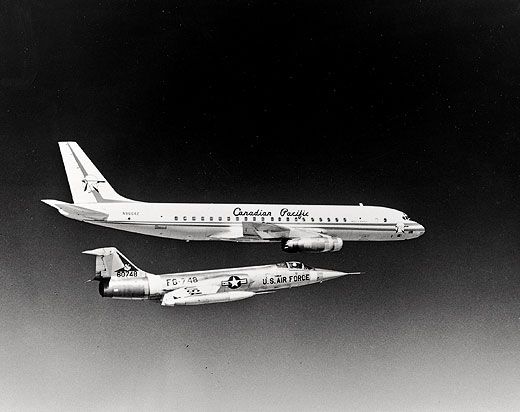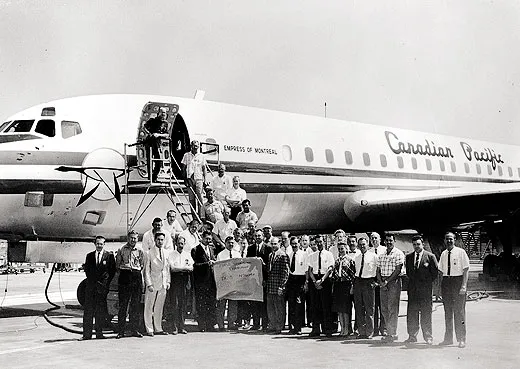I Was There: When the DC-8 Went Supersonic
The day a Douglas DC-8 busted Mach 1
/https://tf-cmsv2-smithsonianmag-media.s3.amazonaws.com/filer/Boeing_will_never_try_it_2_FLASH.jpg)
On August 21, 1961, pilot William Magruder, copilot Paul Patten, flight engineer Joseph Tomich, and flight test engineer Richard H. Edwards took Douglas DC-8-43 no. N9604Z for a test flight at Edwards Air Force Base in California. The aircraft exceeded Mach 1—the only intentional supersonic flight by an airliner other than the Concorde and the Tu-144. Bill Wasserzieher interviewed Richard Edwards in May 2007.
BW: Tell me about the supersonic DC-8 flight.
RHE: That was Bill Magruder’s idea. Very smart—get it out there, show the airplane can survive this and not fall apart. Boeing will never try it [with the 707] because they don’t want to be second. I’m sorry if that affects anybody but that’s just the way it was. We took it up to 10 miles up, 52,000 feet—that’s a record—and put it in a half-a-G pushover. Bill maintained about 50 pounds of push. He didn’t trim it for the dive so that it would want to pull out by itself. In the dive, at about 45,000 feet, it went to Mach 1.01 for maybe 16 seconds, then he recovered. But the recovery was a little scary. When he pulled back, the elevator was ineffective; it didn’t do anything, so he said, “Well, I’ll use the stabilizer,” and the stabilizer wouldn’t run. It stalled, because of the load. What he did, because he was smart, is something that no other pilot would do: He pushed over into the dive more, which relieved the load on the stabilizer. He was able to run the [stabilizer] motor, with the relieved load, and he recovered at about 35,000 feet. That’s an unofficial supersonic record, payload record, and of course an altitude record for a commercial transport. I think it took about 10 years for the SSTs to beat that.
BW: Magruder won the Society for Experimental Test Pilots award, the Iven Kincheloe.
RHE: Yes, he also gave a speech on the Mach 1 dive, and warned pilots that a similar problem might happen to them. He was well known in the industry and very articulate, well educated, with a lot of new ideas. I think Douglas would have liked him to stay, but he made the decision to go to Lockheed.
BW: How much planning went into the flight?
RHE: They had to determine the pushover load factor, the dive angle, to be sure they got to Mach 1.01 at a rather high altitude, so the airspeed wouldn’t be that high up there. [The speed of sound at altitude] is not 700 miles per hour: it’s a lot less. The aerodynamics department, I think under Roger Shaufele, prepared a set of charts. The Mach number itself isn’t used in a dive as a target because it’s much more accurate to use airspeed. So every thousand feet I would read off to Bill the airspeed [he needed] at the next altitude. As we were coming down, I was talking almost all the time because at a descent rate of 500 feet per second, every two seconds we were 1,000 feet lower. Looking out the window—which I stopped doing—it looked like it was straight down.
We took off at Long Beach and flew to Edwards. We only had fuel for a half-hour flight once we got there, because we wanted to be light, to climb. The night before, at Long Beach, somebody had dinged the slots [devices under the wing leading edges that improved low-speed lift], and they didn’t work. We took off with flaps up, which is kind of a no-no because at takeoff thrust, you can’t control the airplane if it loses an engine with flaps up—there’s an interlock on the rudder.
BW: Was it a tug or something that dinged up the slots?
RHE: I’m not sure. It was something that happened in maintenance. The question was: Do we go or not? Bill said, “Well, we can take off with no flaps and the airplane will be all right—if we don’t lose an engine.”
BW: Amazing the number of times people with tugs moving airplanes have managed to do that.
RHE: I did it myself, calibrating the flaps. We’d go down in two-degree increments and hand-mark the dials in the cockpit so the pilot would know where the flaps [settings] are. The crew chief told me to put the flaps down. Nobody saw the crew [work] stand out there, and we dinged [a flap]. Fortunately, the crew chief was a nice guy and took the blame: He said he should have looked.
BW: What did [going supersonic] feel like?
RHE: Well, really, the sensation was not there at Mach 1.01. At .96 Mach it buffeted for a while….
BW: So there was a little bit of a wall….
RHE: Yeah, and a little above .96 it went away, and it came back as we slowed down to .96. The thing that impressed me the most was the dark, black sky. I’d never seen anything like that. I’m sure our military pilots are familiar with it. I had mounted some cameras in the middle of the airplane, shooting out each window. I wanted to catch the [F-100 and F-104] chase airplanes out there, but I never saw the chase airplanes in the pictures. But it did show the ailerons flapping up as the shock wave left—I think it was about .97 Mach. They went up about five degrees, I think—both sides, fortunately.
BW: What did it feel like to walk on the ground again after you set down?
RHE: We were all smiles. We weren’t frightened, but we were more or less happy that we had got there. Initially, on all the flight tests we’d shoot for maximum design Mach number on each new design, which was .95 Mach. We’d normally overshoot a little so we’d be sure we would get it, so we got up to .97 quite a few times. And Bill said, “Well, if we can get up to .97, we can get up to 1.01. That’s not so far away.”
BW: You must have felt like you were a part of aviation history, a little like an early astronaut.
RHE: A little bit. [Douglas Aircraft Company president] Jackson McGowen came down and met us at the executive lunch room, the first time I’d ever been in there, and bought us all lunch. So we were kind of pleased with that. And John Londelius, VP of Flight Test, gave us each a $1,000 bonus, so that was rather nice. That was back when a thousand dollars was worth a thousand dollars.
N9604Z was delivered to Canadian Pacific Air Lines, where it served for nearly 19 years. In 1980, it was sold for scrap.
Aviation historian Bill Wasserzieher interviewed Douglas employees for the Douglas White Oaks Trust project, which comprises some 50 oral histories.

